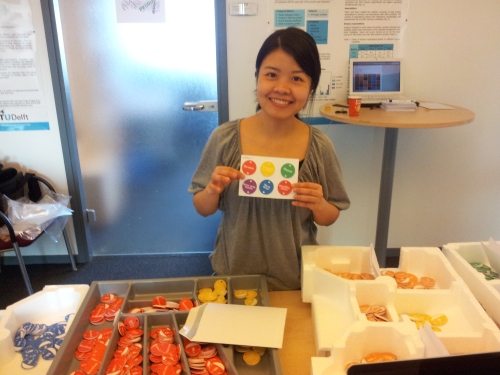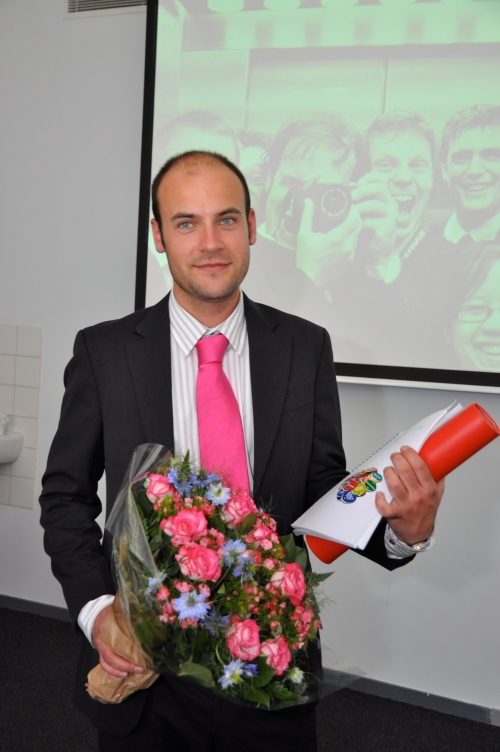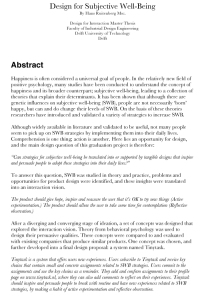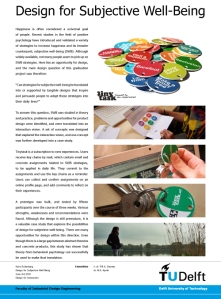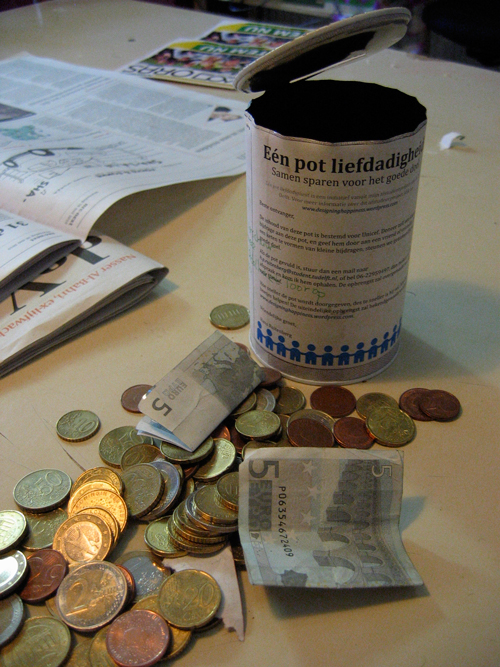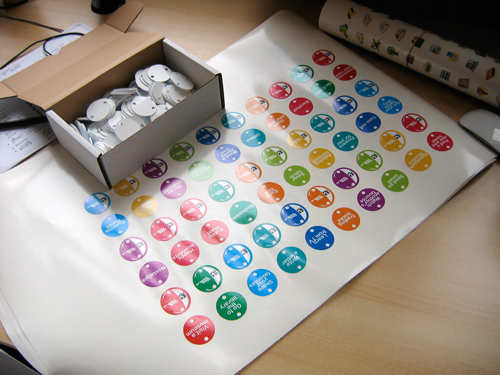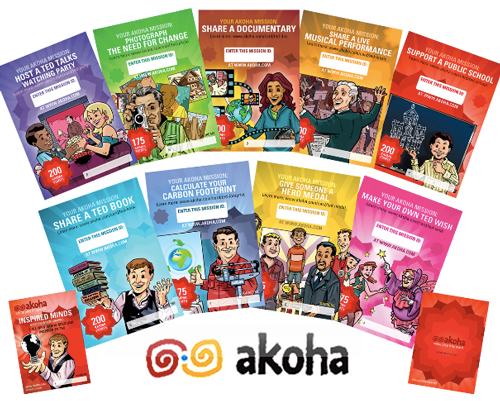After a thorough analysis it was finally time to get creative! In this post I’ll tell about my first ideas and concepts for a product that can help people adopt a happiness strategy in their daily life.
Sketching exercises
The design focus is to combine elements of experiential learning (active experimentation and reflective observation) with the strategies of Lyubomirsky. At this point the main goal is to explore and generate ideas without too many constraints, as it is important to diverge in the early stages of this phase (Tassoul, 2007, p. 32). Hence, there is no focus on any strategy in particular, nor on a specific target audience for which must be designed. Ideas were generated during a number of sketching exercises. Different brainstorming and problem solving techniques were used to ensure a comprehensive result.
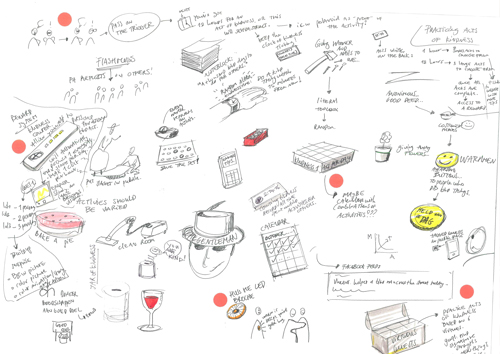

First ideas
Ideas that captured my immediate interest were explored a bit further. Among others are these examples:

This is an envelope with a thank-you message. Inside the envelope is another envelope with a thank-you message, with another envelope inside, etc. The envelopes are all sealed and already contain postage. The user that buys the product sends it to someone as a thank-you. When the recipient opens the envelope, he discovers that in turn he can thank someone by sending it again. Thus a chain of thank-you letters comes into being. The initiator of the chain is rewarded by the knowledge that he has set in motion a chain of thank-you’s.
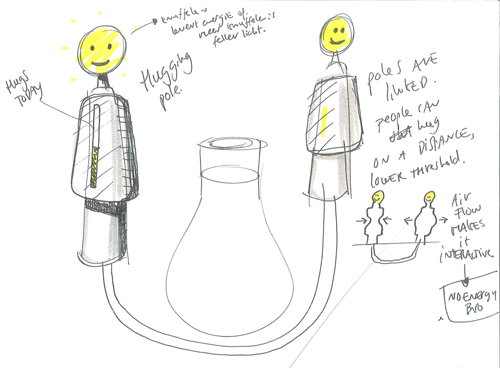
This is a hugging pole. It is intended to cause unfamiliar people to hug, without having to break through their comfort zones. The poles have humanly shapes, and are filled with air. When one pole is hugged, the air is transferred through underground pipes to another pole. The movement of air will cause the poles to shrink or expand, allowing people to ‘hug each other without touching’ by hugging the poles. The poles could contain motivational elements, such as a hug counter ‘total hugs today: …’, or a head with a light that starts to glow when hugged.
Creative session
Two creative sessions were organized to generate an extra dose of ideas. I differentiated from my previous ideation, by choosing not to focus on Lyubomirsky’s strategies, but on Seligman’s framework of virtues (2003).
There is a lot of overlap between Seligman’s framework of virtues and Lyubomirsky’s strategies, but there are some distinct differences. Lyubomirsky’s strategies are valuable because they have been tested intensively and are formulated on a concrete level. The translation from Lyubomirsky’s stategies to products should be easier than from Seligman’s list of abstract virtues.
However, virtues are simple, elegant, and universally accepted concepts. They are authentic and meaningful, which makes them more socially acceptable for someone to pursue rather than more hedonic antisocial strategies. In that sense, virtues could be a successful communication strategy for a product that is based on a multiple of Lyubomirsky’s strategies.
To explore the possibilities of virtues in happiness-inducing products, I chose to focus my creative sessions on Seligman’s six virtues. The first session concerned wisdom and knowledge, love and humanity, and temperance. During the second session, courage, justice, spirituality and transcendence were the three subjects. The main three exercises were as follows:
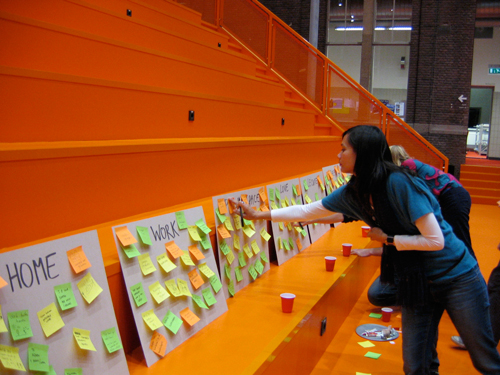
1) There are cardboard tiles for different domains: Work, Home, Public Space, Love, Leisure, Self, Family and Friends. The participants are asked to think of examples of the display of virtues in various domains. They must write their ideas on post-its, and put them in the appropriate domains. Each of the three virtues of the session is addressed for 10 minutes.

2) There will be a small competition, and the group is split into two teams. Each team receives 15 envelopes. Every envelope contains a paper with a strength written on it. All strengths are related to the virtues of the session. For every strength the teams have to make a chain association: strength > product > product > product. A3s with a grid and arrows are provided for every chain. There are some elements to inspire and motivate the participants, such as extra assignments hidden in the envelopes and a small prize.
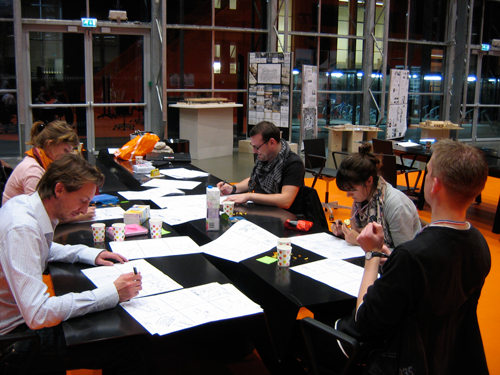
3) Creating examples of using a product to stimulate the exercise of virtue in a certain domain.
In groups of two, the participants will create two concepts, each combining a virtue/domain and a strength/product from the walls. The concepts will be visualized on an A3. Afterwards, the teams will shortly present their concepts to the group, allowing some time for short discussion.
The participants were quite able in combining the outcomes of the first two exercises into concepts during the third exercise. The sessions have generated loads of interesting ideas. The majority of them display strong relations with some of Lyubomirsky’s strategies.
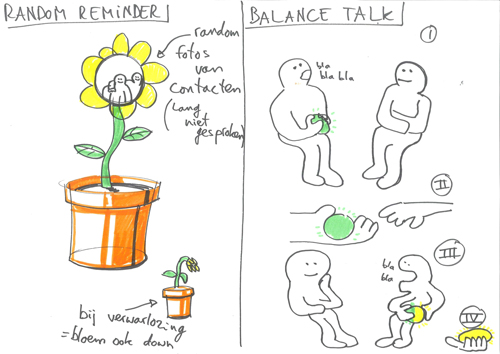
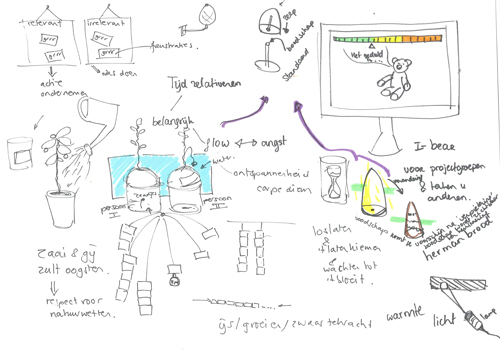
Sense making
The sketching exercises and creative session resulted in a great variety of ideas of different shapes and sizes, which incorporated many different concepts of interaction. To find more focus and enable a good choice, the ideas had to be analyzed.
All ideas were clustered, and their common aspects were identified. Some interesting aspects that could be found in multiple ideas were: a random trigger that inspires action, passing on the product as part of the lesson, letting the product give examples and suggestions of activities and experiments, providing a physical ritual, creating an atmosphere for the user, etc. These aspects were analyzed to find idea dynamics that could be applied in design. I will give some examples of the dynamics that were found:

This graph represents the amount of functions in a product, and the user satisfaction with the product. When there are too few functions, the user is not satisfied because the product does not answer his needs. When there are too many functions, the user is not satisfied because the product is too complex, and offers him functionalities he does not need of want. An optimum has to be found where there is enough functionality but not too much.

The product ideas fit into different contexts: Some are to be used at home, some in public space, and some are mobile. It seems that for active experimentation, a mobile product is most versatile, since it can be used in many contexts. For reflective observation one needs to be in a comfortable environment, thus reflective observation can best be done at home.
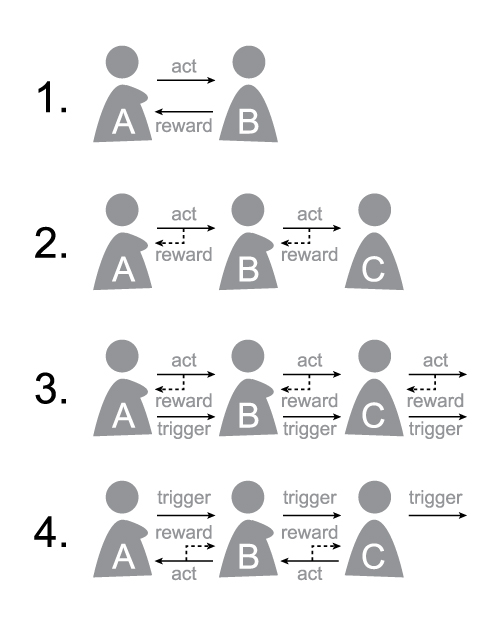
Passing on products is an interesting mechanism. It can add value, since one small action by an initiator can lead to so many more. This potential chain reaction is an extra reward on top of the intrinsic reward of doing the act. Passing on the product also gives a sense of closure to following the strategy. When starting out with a lot of assignments, being able to give them all away will feel like an accomplishment. Finally, the factor of serendipity is interesting. People can be the lucky recipients of a kind act or of a trigger. Also, the initiator may stumble upon traces of the chain again, or may even track it in some way.
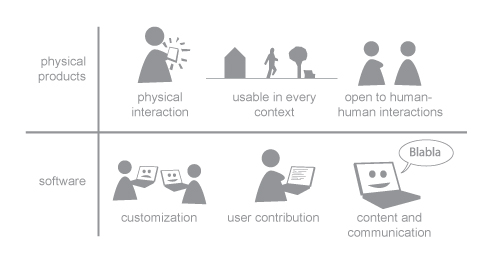
This diagram shows the unique benefits of physical products compared to software, and vice versa. Unlike software, physical products afford physical interaction; can be used regardless of context (no need of a computer or Wifi network); and leave more room for human-human interaction. These aspects are all important when trying to evoke active experimentation. Unlike physical products, software allows for easy customization and user contribution, and is great at providing content and communication. These aspects are all very suitable for reflective observation, where it is important for users to express, share and discuss their experiences.
Concept direction
The ideas that had been generated and the dynamics that had been identified inspired the formulation of a concept direction:
The concept direction is a generic system with specific products. One system with clear rules and functionalities, that contains simple products, customized to suit different users. The products should give the user small concrete assignments related to his happiness strategy, in the shape of examples and suggestions of activities and experiments. The products act as random triggers that inspire action, and should be passed it on as part of the lesson. The experiments give the user a different take on things. Using contemplation tools, the user reflects on his experience through a ritual. The products for active experimentation should be mobile and physical. The products for reflective observation should consist of software, and be used primarily in the home environment.
Interaction vision
Now that the concept direction had been described in abstract terms, it needed to be developed into a more concrete design. Theory on persuasion by BJ Fogg was used to aid this conceptualization. Fogg’s elements of motivation, ability and trigger are strongly related to active experimentation and others to reflective observation. These elements will have to be addressed in the final design. An interaction vision was developed for this purpose.
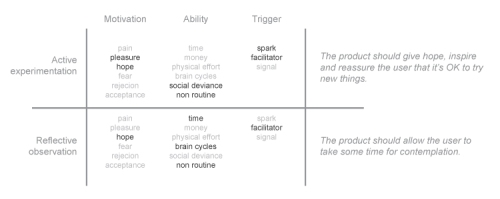
Active experimentation: The product should give hope, inspire and reassure the user that it’s OK to try new things.
Reflective observation: The product should allow the user to take some time for contemplation.
Concept explorations
I have explored the interaction vision in sketches, gradually making the concept direction more concrete.
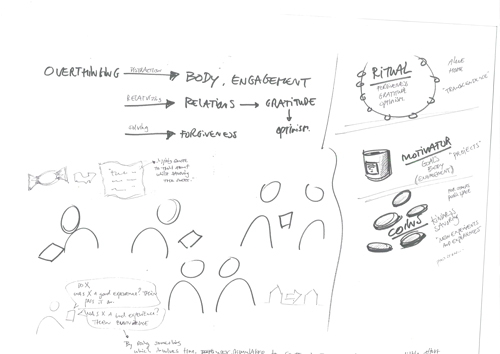
Concept description
After some iteration I formulated a preliminary concept description.

A container with coins that have small assignments printed on them. These assignments are related to the happiness strategy the user wants to adopt.
The goal for the user is to empty the container, thereby making a habit of behaving in a way that fits his strategy. The assignments should have a low threshold by being fun, meaningful, concrete, and simple. They will still require some commitment from the user, otherwise he will get no feeling of achievement.
After having completed an assignment, the user types a testimonial on a special website, and passes the coin to someone else. The recipient of the coin is meant to do the exercise as well, type a testimonial, pass the coin on to someone else, etc.
On the website, all the testimonials that are linked to one coin will cerate a meaningful story for all people involved in the chain. The story will be a reward for the initiators, and a motivation for the recipients in the chain.
Storyboard
The use of this product can be visualized in a storyboard, and consists of the following stages: Acquisition; unpacking and placement; receiving assignments; preparation; action and consequence; contemplation; progress; end of life. These stages were developed a bit further.
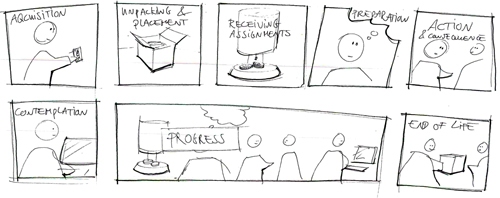
Acquisition > The product can be bought online and at retail stores. If people buy it online, they can customize their coins by doing a PAF test. Retail stores have sets of coins for every strategy. Coins can have different colors so that they can be recognized easily.
Users will come into contact with the product through the web, or by receiving a coin in real life.
Unpacking and placement > The container has to be placed in a location in the home that is visible, so that it can remind users of their commitment. Therefore, it should look good and fit in people’s interiors. Maybe there should be no container at all? Maybe people should just use a bowl they already have at home which they like?
Receiving assignments > To be open and flexible, all coins are available to the user at once. This also makes progress towards their goal very obvious. Maybe there can be a reward system: they will receive an extra coin by mail, upon having completed all coins of a certain strategy. This will encourage users to finish a strategy.
Preparation > During the stage of preparation, the user can experience many emotions that either support or object the execution of the assignment. The threshold has to be low to minimize the chance of giving up. Therefore, the assignments on the coins need to be small, feasible and concrete.
Action and consequence > The assignment should strive to offer an engaging experience, which is gratifying by itself. Action and contemplation shouldn’t interfere, as that could lead to a distorted experience. Individual assignments differ from social assignments. Individual assignments can be anonymous, while social assignments often involve interaction with other people, and will also concern the dynamics of reciprocity.
Contemplation > In order to afford contemplation one needs a comfortable environment. The activity of contemplating can involve a form of expression to allow the user to rearrange his thoughts and put them into perspective. Action and contemplation shouldn’t interfere, as that could lead to a distorted appraisal. It would be suitable to reflect on assignments at home, through expressing, sharing and discussing experiences online.
Progress > A user should be able to see progress in completing the assignments. A condition for observing progress is having an overview of the amount of assignments that have been completed, and the amount that still needs to be. Seeing progress can be as simple as seeing a bowl of coins slowly becoming empty.
End of life > The product has reached its end-of-life when the first user has given away all the coins. However, the coins will be spread and create their own paths. The stories of all the coins remain on the Internet as a reminder. When the coins come in a container, the empty container is left behind when the coins have been given away. It may be put to some other use, such as a bowl or vase.
In the next stage of the project, I will further develop the concept, and work towards a prototype that can be tested with real users.
References
– Lyubomirsky, S. (2007). The How of Happiness. New York: The Penguin Press.
– Seligman, M. E. (2003). Authentic Happiness. London: Nicolas Brealey Publishing.
– Tassoul, M. (2007). Creative Facilitation. Delft: TU Delft.

